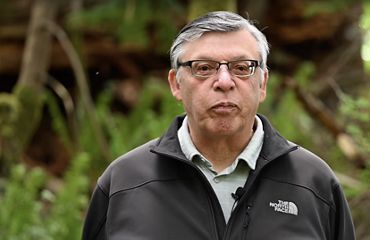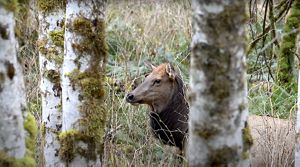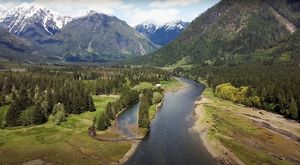Working Together Towards “Living Tree Tenures”: Kwiakah First Nation’s Journey to Restore Old-Growth Forests
A conversation between munmuntle (Chief Steven Dick) of Kwiakah First Nation and Laura Smith, Nature United’s Forest and Climate Specialist.
Ten years ago, the Kwiakah First Nation laid out a vision to regain authority over their forests and restore them to what they once were — ancient cedars towering over a diversity of plant life, from ferns to devil’s club. Over the last couple of years Nature United has played a strategic role as a partner — ensuring Kwiakah had the tools and resources necessary to advance their vision with the Province and other operators on their territory.
On May 24, 2024, the Kwiakah First Nation, alongside the Province of BC, announced the creation of the M̓ac̓inuxʷ Special Forest Management Area (SFMA), transitioning 7,866 hectares of forest previously designated for commercial forestry to a new tenure that aligns with Kwiakah’s vision of regenerative forestry practices. For this agreement, Nature United provided $3M to Kwiakah as part of the transition.
Nature United’s Forest and Climate Specialist, Laura Smith, met with munmuntle (Chief Steven Dick) to discuss what it’s taken to get to this juncture and what the road ahead holds for the Nation.

Laura Smith: This announcement is a huge achievement for the Kwiakah First Nation, and a long time in the making. Can you tell us more about your vision and how it feels to be at this point?
Chief Steven: You’re right, it has taken a long time. Kwiakah’s inherent stewardship responsibilities are handed down from generation to generation. This ancestral connection has taught us to respect all living creatures and take only what we need.
Our membership has affirmed conservation as a guiding principle in our Nation’s constitution. This creates a clear directive for us to govern our territory in a manner that respects the interconnectedness between the land and all it provides. It gives me great pride to be able to create an agreement that will bring M̓ac̓inuxʷ back to a healthier state, and for future generations to be able use the resource as our ancestors had done for centuries.
These efforts have just begun, but it’s an important first step of many towards rebuilding systems that will protect and restore forests while enabling all beings to thrive.
Quote: munmuntle (Chief Steven Dick)

This vision will create jobs and an economy that prioritizes the well-being of both ecosystem and communities.
LS: This project transitions from industrial tree farm licenses to what Kwiakah are calling a “Living Tree Tenure.” Can you tell us more about what this looks like?
CS: Simply put, it means moving away from extractive practices and building a new model that values living trees. It will also embrace other economic instruments, such as carbon credits, instead of profiting from killing trees. And then there are the other benefits that come from healthy forests. For instance, instead of dealing with the pollution and environmental disruption created by industrial logging, we will move towards securing healthy water, which is connected to salmon habitat and other relations such as grizzly bears and elk.
This vision will also create jobs and an economy that prioritizes the well-being of both ecosystem and communities. Over time, we will expand our conservation economy to include other economic opportunities beyond regenerative forestry, ranging from sustainable kelp farming and ecotourism to entrepreneurial opportunities.


LS: How do you hope it will change Kwiakah’s social and cultural connection with their lands?
CS: Well, I hope to see Kwiakah people out on our lands and waters again after almost 100 years of separation. We now have a base of operation for our Forest Keepers and Guardians, and we are in the process of repurposing former fish-farm buildings into a Centre of Excellence for the research of regenerative forestry at the heart of our territory. Together, research and traditional knowledge will support us as the rightful decision-makers — as we were for millennia.
And it’s already happening. We recently had a young member who was away at university come back to do research on clam gardens in the territory. Restoring the connection our youth have with our territory is key to protecting the future of our lands and our people.
Quote: munmuntle (Chief Steven Dick)

We believe that we’ve created a functioning blueprint that other Nations can follow and adjust to their specific visions and needs.
LS: What were the greatest obstacles in realizing this project and how did you overcome them?
CS: One of the greatest obstacles that we faced early on is the size of our Nation — we’re the second-smallest Nation in B.C., and I don’t believe we were taken seriously.
When legislation was passed to add protection for the Great Bear Rainforest [in 2016], everyone celebrated, but for Kwiakah, it was not a positive outcome. Logging was restricted across the rainforest, but the protections were not distributed evenly. We actually lost 20% of our forest protection. And while some might say that the harvesting was sustainable, what I see is huge areas of forest that are gone.
One turning point was meeting organizations, such as Nature United, that share our vision around conservation and sustainable economies. These organizations supported Kwiakah so we could afford to properly engage with industry and government. One of the major effects of that — and one that is often less recognized — is that our partnership with Nature United has supported true reconciliation. It’s very important for Kwiakah to define what reconciliation means to our Nation. Part of reconciliation is regaining control of our territory again. Connected to that is economic reconciliation. We can now start to co-manage our territory and build an economy in a way that aligns with who we are as Kwiakah people.
LS: Do you see Kwiakah’s vision and progress having an impact beyond your Nation and territory?
CS: I hope that our project empowers other Indigenous communities to consider an alternative economic model to extractive industrial systems. We believe that we’ve created a functioning blueprint, or proof of concept, that other Nations can follow and adjust to their specific visions and needs. We also hope what Kwiakah is doing here, in collaboration with the Province of B.C. and Nature United and others, motivates other governments to support similar initiatives and funders to collaborate with each other and other First Nations.
At the end of the day, I hope that what Kwiakah has done inspires other Nations to be courageous in engaging governments and industries in a new way. If a small Nation like us can be successful, larger groups might achieve even more.




